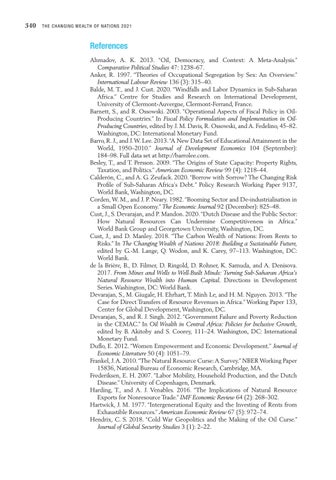340
T H E C H A N G I N G W E A LTH O F N ATIO N S 2021
References Ahmadov, A. K. 2013. “Oil, Democracy, and Context: A Meta-Analysis.” Comparative Political Studies 47: 1238–67. Anker, R. 1997. “Theories of Occupational Segregation by Sex: An Overview.” International Labour Review 136 (3): 315–40. Balde, M. T., and J. Cust. 2020. “Windfalls and Labor Dynamics in Sub-Saharan Africa.” Centre for Studies and Research on International Development, University of Clermont-Auvergne, Clermont-Ferrand, France. Barnett, S., and R. Ossowski. 2003. “Operational Aspects of Fiscal Policy in OilProducing Countries.” In Fiscal Policy Formulation and Implementation in OilProducing Countries, edited by J. M. Davis, R. Ossowski, and A. Fedelino, 45–82. Washington, DC: International Monetary Fund. Barro, R. J., and J. W. Lee. 2013. “A New Data Set of Educational Attainment in the World, 1950–2010.” Journal of Development Economics 104 (September): 184–98. Full data set at http://barrolee.com. Besley, T., and T. Persson. 2009. “The Origins of State Capacity: Property Rights, Taxation, and Politics.” American Economic Review 99 (4): 1218–44. Calderón, C., and A. G. Zeufack. 2020. “Borrow with Sorrow? The Changing Risk Profile of Sub-Saharan Africa’s Debt.” Policy Research Working Paper 9137, World Bank, Washington, DC. Corden, W. M., and J. P. Neary. 1982. “Booming Sector and De-industrialisation in a Small Open Economy.” The Economic Journal 92 (December): 825–48. Cust, J., S. Devarajan, and P. Mandon. 2020. “Dutch Disease and the Public Sector: How Natural Resources Can Undermine Competitiveness in Africa.” World Bank Group and Georgetown University, Washington, DC. Cust, J., and D. Manley. 2018. “The Carbon Wealth of Nations: From Rents to Risks.” In The Changing Wealth of Nations 2018: Building a Sustainable Future, edited by G.-M. Lange, Q. Wodon, and K. Carey, 97–113. Washington, DC: World Bank. de la Brière, B., D. Filmer, D. Ringold, D. Rohner, K. Samuda, and A. Denisova. 2017. From Mines and Wells to Well-Built Minds: Turning Sub-Saharan Africa’s Natural Resource Wealth into Human Capital. Directions in Development Series. Washington, DC: World Bank. Devarajan, S., M. Giugale, H. Ehrhart, T. Minh Le, and H. M. Nguyen. 2013. “The Case for Direct Transfers of Resource Revenues in Africa.” Working Paper 133, Center for Global Development, Washington, DC. Devarajan, S., and R. J. Singh. 2012. “Government Failure and Poverty Reduction in the CEMAC.” In Oil Wealth in Central Africa: Policies for Inclusive Growth, edited by B. Akitoby and S. Coorey, 111–24. Washington, DC: International Monetary Fund. Duflo, E. 2012. “Women Empowerment and Economic Development.” Journal of Economic Literature 50 (4): 1051–79. Frankel, J. A. 2010. “The Natural Resource Curse: A Survey.” NBER Working Paper 15836, National Bureau of Economic Research, Cambridge, MA. Frederiksen, E. H. 2007. “Labor Mobility, Household Production, and the Dutch Disease.” University of Copenhagen, Denmark. Harding, T., and A. J. Venables. 2016. “The Implications of Natural Resource Exports for Nonresource Trade.” IMF Economic Review 64 (2): 268–302. Hartwick, J. M. 1977. “Intergenerational Equity and the Investing of Rents from Exhaustible Resources.” American Economic Review 67 (5): 972–74. Hendrix, C. S. 2018. “Cold War Geopolitics and the Making of the Oil Curse.” Journal of Global Security Studies 3 (1): 2–22.


